Military history of Cuba
The Military history of Cuba begins with the island's conquest by the Spanish and its battles afterward to gain its independence. After the Communist takeover by Fidel Castro in 1959, Cuba became involved in many major conflicts of the Cold War in Africa and the Middle East, where it supported Marxist governments and fought against Western proxies. Castro's Cuba had some 39,000–40,000 military personnel abroad by the late 1970s, with the bulk of the forces in Sub-Saharan Africa but with some 1,365 stationed in the Middle East and North Africa.[1]
Part of a series on the |
|---|
| History of Cuba |
 |
| Governorate of Cuba (1511–1519) |
| Viceroyalty of New Spain (1535–1821) |
| Captaincy General of Cuba (1607–1898) |
| US Military Government (1898–1902) |
| Republic of Cuba (1902–1959) |
|
| Republic of Cuba (1959–) |
| Timeline |
|
|
| Topical |
|
|
| Military of Cuba |
|---|
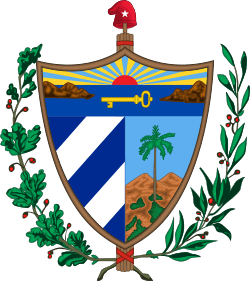 |
| Branches |
|
| Related articles |
Colonial period (1511–1902)
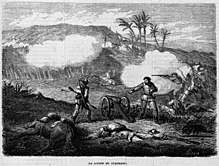
Ten Years' War
The Ten Years' War (1868–78) was the first of three wars that Cuba fought against Spain for its independence. The Ten Years' War began when Carlos Manuel de Céspedes and his followers of patriots from his sugar mill La Demajagua began an uprising. Dominican exiles, including Máximo Gómez, Luis Marcano and Modesto Díaz, joined the new Revolutionary Army and provided its initial training and leadership.[2] The war ended with the signing of the Pact of Zanjón. Spain sustained 200,000 casualties and the island sustained over $300 million in property damage.[2]
Cuban War of Independence
The Cuban War of Independence (1895–98) was the last major uprising by Cuban Nationalists against the Spanish Colonial Government. The conflict culminated with American intervention during the Spanish–American War.
Spanish–American War
The Spanish–American War was a major war fought by the United States and the Kingdom of Spain in the Spanish territories of Cuba, Puerto Rico, and the Philippines. The war was triggered with the sinking of the USS Maine in Havana Harbor. Cuban rebels fought alongside American troops throughout the war on the Cuban island. The war lasted for 10 weeks.
.jpg)
Cuba was occupied by US military troops on July 17, 1898. In the Treaty of Paris (1898), Spain renounced its sovereignty over Cuba without naming a receiving country. Cuba then established its own civil government, which was recognized by the United States as the legal government of Cuba upon the announcement of the termination of United States Military Government (USMG) jurisdiction over the island on May 20, 1902. This date is celebrated as Independence day for the Republic of Cuba.
Early republic (1902–1959)
Spanish Civil War
Approximately 1,000 Cubans fought in Spain in the 1936–39 Spanish Civil War (nearly all of them in the Communist ranks of the International Brigades).[3]
World War II
Cuba entered World War II in December 1941. The Cuban Navy performed convoy escort duties and antisubmarine patrols during the Battle of the Caribbean; despite its small size, the Cuban Navy quickly developed a reputation for being extremely efficient. The most notable success of Cuban forces was the sinking of German submarine U-176 by a Cuban submarine chaser squadron. Six Cuban merchant vessels were sunk by German submarines in the conflict and 79 Cuban sailors were killed.
1952 coup
Military strongman Fulgencio Batista staged a coup on March 10, 1952, removing Carlos Prío Socarrás from power. Cubans in general were stunned, but remembering the bloodshed of the Batista's rule in the 1930s, they were reluctant to fight. Batista created a consultative council from pliable political personalities of all parties who appointed him President months before elections were to be held. Batista’s past democratic and pro-labor tendencies and the fear of another episode of bloody violence gained him tenuous support from the bankers, and the leader of the major labor confederation.
The Cuban Revolution
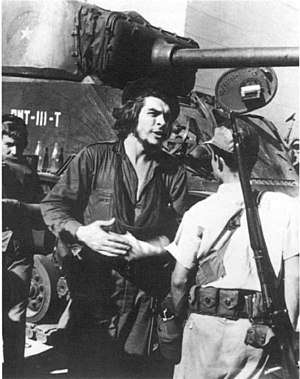
The Cuban Revolution started as an uprising that resulted in the overthrow of the Fulgencio Batista government on January 1, 1959 by Fidel Castro and other revolutionary elements in the country. The Revolution began on July 26, 1953, when a group of armed guerrillas attacked the Moncada Barracks.
From 1956 through the middle of 1958, Castro and his forces staged successful attacks on Batista garrisons in the Sierra Maestra mountains. Che Guevara and Raúl Castro helped to consolidate rebel political control in the mountains through guerrilla fighting, building trust with campesinos, and severely punishing traitors and informers. The irregular and poorly armed rebels harassed the Batista forces in the foot hills and the plains of Oriente Province.
The final blow to Batista government came during the Battle of Yaguajay. Castro’s forces were able to capture the garrisons at Santa Clara along with the second largest city. As a result, Batista fled the country and Castro came into power.
Post-revolution Cuba (1959–present)
Dominican Republic invasion attempt
Cuban military intervention abroad began on 14 June 1959 with an attempted invasion of the Dominican Republic by a mixed group of Cuban soldiers and Cuban-trained Dominican irregulars.[4] The expeditionary force was massacred just hours after having disembarked.[5]
Bay of Pigs Invasion
The Bay of Pigs Invasion (known as La Batalla de Girón in Cuba), was an unsuccessful attempt by a U.S.-trained force of Cuban exiles to invade southern Cuba with support from U.S. armed forces to overthrow the Cuban government of Fidel Castro. The plan was launched in April 1961, less than three months after John F. Kennedy assumed the presidency in the United States. The Cuban armed forces, trained and equipped by Eastern Bloc nations, defeated the exile combatants in three days. Bad Cuban-American relations were exacerbated the following year by the Cuban Missile Crisis.
Cuban Missile Crisis

The Cuban Missile Crisis (October Crisis in Cuba) was a confrontation between the United States and the Soviet Union over nuclear missiles that were deployed in Cuba and Turkey. The Russian missiles were placed both to protect Cuba from further attacks by the United States after the failed Bay of Pigs Invasion, and in response to the U.S. deploying Thor missiles with nuclear warheads on the Soviet border in Turkey.
The situation reached the crisis point when U.S. reconnaissance imagery revealed Soviet nuclear missile installations on the island, and ended fourteen days later when the Americans and Soviets each agreed to dismantle their installations, and the Americans agreed not to invade Cuba again.
Congo Crisis
The Congo Crisis was a period of turmoil in the Congo that began with national independence from Belgium and ended with the seizing of power by Joseph Mobutu. During the Congo Crisis, a Cuban expedition led by Che Guevara trained the Simba rebels to fight against the weak central government of Joseph Kasa-Vubu and the forces of Mobutu Sese Seko. This would be Cuba's first military action in Africa. The rebellion failed, leading the Cuban mission to withdraw.
Guinea-Bissau War of Independence
Some 40–50 Cubans fought against Portugal in Guinea-Bissau each year from 1966 until independence in 1974; several Cubans were killed in the field by Portuguese troops.[4]
Bolivia Insurgency

During the 1960s, the National Liberation Army began a Communist insurgency in Bolivia. The National Liberation Army was established and funded by Cuba and led by Che Guevara.
The National Liberation Army was defeated and Che Guevara was captured by the Bolivia government aided by the U.S. Central Intelligence Agency. Bolivian Special Forces were informed of the location of Guevara's guerrilla encampment. On October 8, the encampment was encircled, and Guevara was captured and later executed by Bolivian forces.
Eritrean War
Cubans trained Eritreans but later, in a political reversal, trained Ethiopian Marxist forces who were fighting against Eritreans.
Yom Kippur War
The Yom Kippur War (1973) was the fifth major conflict between Israel and the neighboring Arab States. Cuba deployed 1,500 troops, including tank and helicopter crews, to support the Arabs during the war. Precise Cuban casualty numbers are unknown.[6]
Ogaden War
The Ogaden War was a conflict between Somalia and Ethiopia between 1977 and 1978. Fighting erupted in the Ogaden region as Somalia attempted to annex it. When the Soviet Union began to support the Ethiopian Derg government instead of the Somali government, other Communist nations followed. The Cuban military deployed 15,000 combat troops along with aircraft to support the Derg government and the USSR military advisors in the region.
The conflict ended with a Somali retreat. The Somali army, which had taken a severe beating from Cuban artillery and air attacks,[7] was destroyed as a fighting force. Cuban losses were 400 killed,[8] 11 tanks and 3 planes.
Cuban intervention in Angola
Between 1975 and 1991, the Cuban military provided support for the left wing MPLA movement in a series of civil wars. During these conflicts the MPLA emerged victorious due in part to the substantial aid received from Cuba.
The Angolan War of Independence was a struggle for control of Angola between guerilla movements and Portuguese colonial authority. Cuba supplied the People's Movement for the Liberation of Angola (MPLA) rebels with weapons and soldiers to fight. The Cuban military would fight alongside the MPLA in major battles.
The Angolan Civil War was a 27-year civil war that devastated Angola following the end of Portuguese colonial rule in 1974. The conflict was fought by the MPLA against UNITA and the National Liberation Front of Angola (FNLA). MPLA was aided by Cuba and the Soviet Union, and UNITA and FNLA were supported by South Africa, United States and Zaire. It became Africa's longest running conflict. Cuban forces were instrumental in the defeat of South African and Zairian troops.[9] Cuban forces also defeated the FNLA and UNITA armies in conventional warfare and established MPLA control over most of Angola.[10]
South African Border War
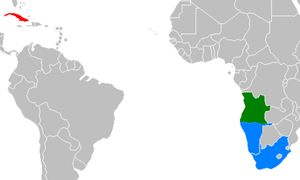
The so-called South African Border War was a conflict that took place in South-West Africa (today the independent nation of Namibia) between the Apartheid-era South African Defence Forces and its allied National Union for the Total Independence of Angola (UNITA) against the South West Africa People's Organization (SWAPO) and the Cuban-backed MPLA. The Cuban army had a major involvement in some of the most important battles, including the Battle of Cuito Cuanavale.
Invasion of Grenada
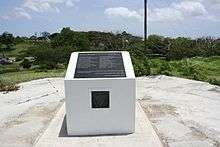
A 748-man Cuban contingent (all but 43 of whom were construction workers) was deployed in Grenada during the invasion of Grenada by U.S. troops in 1983. The Cuban government sent the contingent there to support the leftist government of the country. Cuban losses during the conflict were 24 killed (only 2 of whom were professional soldiers), 59 wounded, and 606 captured (later repatriated to Cuba). In 2008, the Government of Grenada announced a move to build a monument to honor the Cubans killed during the invasion by Genelle Figuroa. At the time of the announcement the Cuban and Grenadian government are still seeking to locate a suitable site for the monument.
Salvadoran Civil War
The Salvadoran Civil War was fought by the El Salvador government waging a vicious crackdown against various left-wing rebels, as well as committing war crimes against civilians, one example of which being the El Mozote massacre. Cuba supplied the rebels with weapons and advisors.
Nicaraguan Civil War
During the Sandinista revolution and the following Civil War, Cuba gave aid and support to the Sandinista government of Daniel Ortega. The Sandinista government was fighting the American backed rebels (aka) Contras. The conflict ended with the 1990 presidential election where Ortega lost to Violeta Barrios de Chamorro.
See also
References
- Suchlicki, Jaime (1989). The Cuban Military Under Castro. Transaction Publishers. p. 41.
- Scheina, Robert L. (2003). Latin America's Wars: Volume 1. Potomac Books.
- Montaner (2001). Journey to the Heart of Cuba: Life as Fidel Castro. Algora Publishing. p. 13.
- "Foreign Intervention by Cuba" (PDF).
- Castañeda, Jorge G. (2009). Companero: The Life and Death of Che Guevara. Knopf Doubleday Publishing Group. p. 147.
- Perez, Cuba, Between Reform and Revolution, p. 377-379
- Kirk, J.; Erisman, H. Michael (2009). Cuban Medical Internationalism: Origins, Evolution, and Goals. Springer. p. 75.
- Clodfelter, Micheal (2017). Warfare and Armed Conflicts: A Statistical Encyclopedia of Casualty and Other Figures, 1492-2015, 4th ed. McFarland. p. 566. ISBN 978-0786474707.
- Holloway, Thomas H. (2011). A Companion to Latin American History. John Wiley & Sons.
- Africa, Problems & Prospects: A Bibliographic Survey. U.S. Department of the Army. 1977. p. 221.